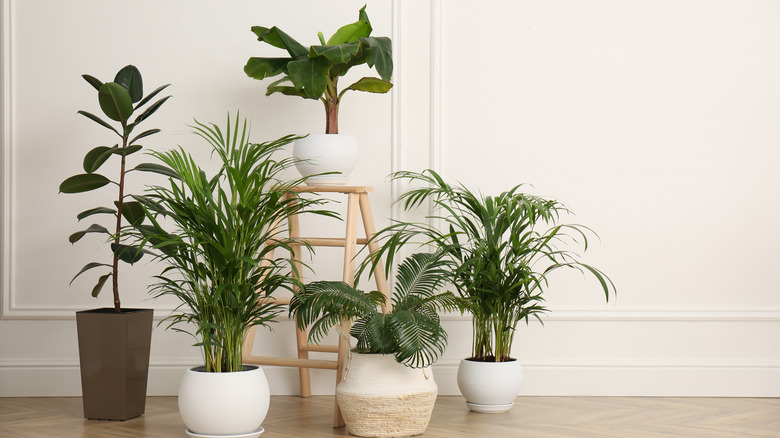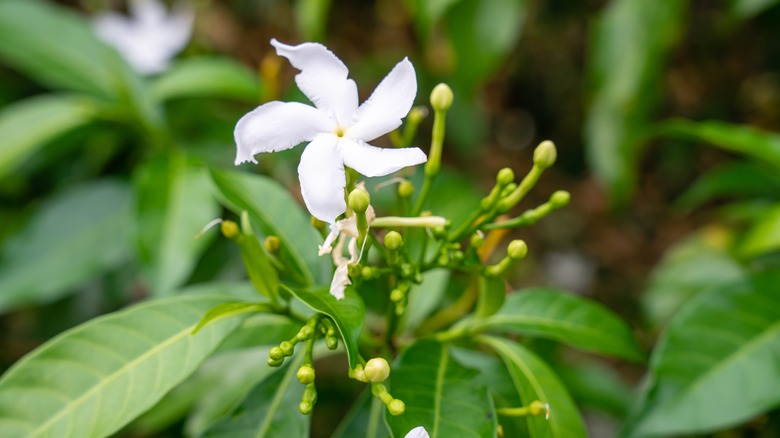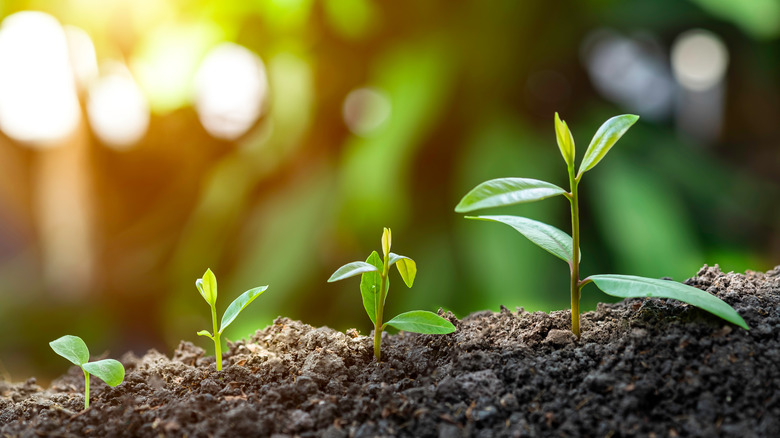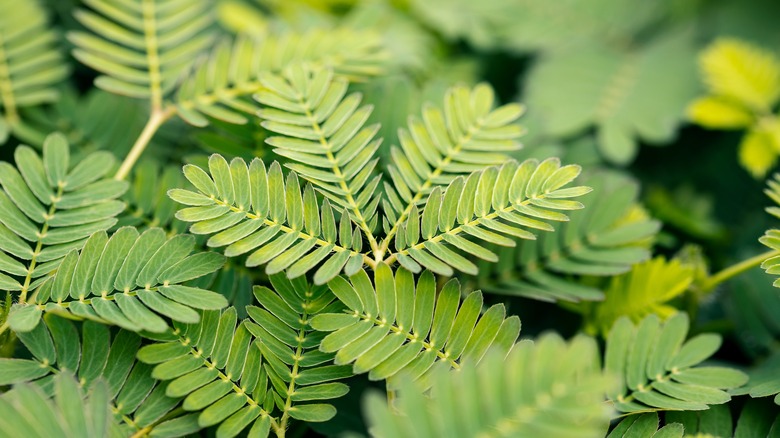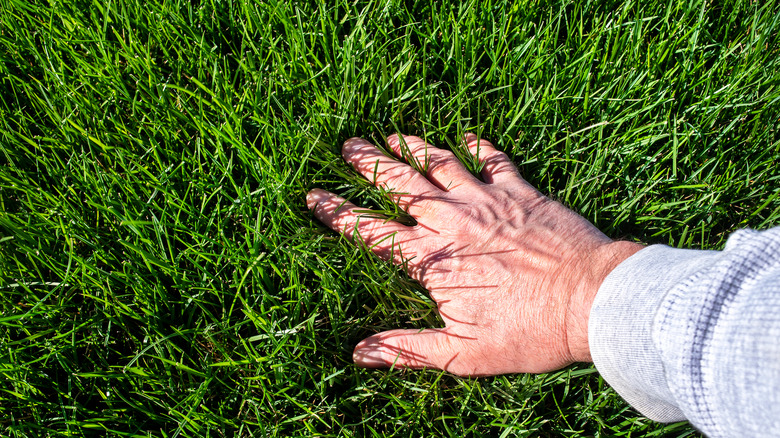Are Plants Conscious?
Most people view plants as little more than scenery: silent, motionless objects with no greater complexity than that which can be seen by human eyes. The truth, however, is far more strange and fascinating, with plants possessing a variety of senses and ways of interacting with the world. As Futurism discusses, plants have long been regarded as having a form of intelligence all of their own, and recent studies suggest they may even have some form of consciousness.
If Earth truly belongs to anyone, then it belongs to plants. According to a study published in PNAS, plants account for around 80% of all life mass on Earth, meaning they outnumber humans. As Science notes, plants emerged on land more than 500 million years ago, and they've shaped the Earth's environment ever since. To humans though, plants mostly go unnoticed because they live on different timescales than animals. As How Plants Work explains, plants effectively live their lives in slow motion compared to humanity. It takes time-lapse videos to show how plants actively perceive and adapt to the environment around them.
Could plants really be conscious? It's a contentious idea, and scientific studies are still far from conclusive. What's certain though, is that they have a set of senses surprisingly similar to those of animals that they use to perceive, learn, and even communicate with each other.
There's a whole group of researchers dedicated to this field
The idea that plants have senses of perception is hotly debated, but proponents point to a steadily increasing pile of evidence suggesting that our leafy neighbors may be a lot smarter than we've been giving them credit for. It may seem like a niche topic of study, but plant cognition has its own dedicated research community. A 2016 paper published in the journal Synthese refers to the field as "Plant Neurobiology," which may seem like a rather odd name. Plants, after all, have no neurons, or any kind of nervous system like animals do — though Quanta Magazine notes that plants transmit signals around their bodies in a way surprisingly similar to animal nerve impulses.
Another 2019 paper published in the Journal of Plant Physiology names this field "Plant Gnosophysiology" and discusses memory and learning in plants — although the authors don't directly compare it to the way animals remember or learn. Debate notwithstanding, several researchers feel strongly enough about this idea to give it serious consideration.
Tree are polite to one another
If you go into any forest around the world and look up, you may notice something about the canopy. Certain trees will avoid overlapping each other's branches, leaving serpentine gaps between the masses of leaves and allowing sunlight to filter down to the forest floor — almost as if the trees are keeping a respectful distance. This phenomenon, National Geographic explains, is known as crown shyness. Scientists aren't entirely certain how or why trees form this way. Regardless, the result is that trees keep their distance, possibly helping to prevent the spread of pests or diseases and also helping trees share the sunlight they need.
Ecology is never simple, so there are likely a number of different causes behind this. National Geographic suggests one may be that the trees have simply learned to stop growing at the right distance from each other. In other words, the trees may be able to sense each other's presence and actively avoid overlapping. There are still missing pieces to this puzzle, though. According to JSTOR Daily, any forest can exhibit crown shyness, but it doesn't happen with all trees. It's most likely to be seen between trees of the same species and approximate age. Seemingly, crown shyness could be one very obvious example of trees not only recognizing their surroundings but also their peers.
Plants share resources
While some trees take care to share sunlight with their neighbors, most also share resources below the soil through a vast mass of roots. According to a study in the journal Plant Physiology, these fine strands of fungus growing between the roots of trees large and small — connecting the entire forest together — are known as mycorrhizal networks. Using this sort of "internet of fungus" to communicate, organisms mutually benefit from each other. In a way that would delight Karl Marx, the wealth of the forest is redistributed through these networks, where plants (and fungi) with more resources readily give away their excess to those with less.
As Mother Tree Project explains, these underground fungal networks allow a forest's largest trees to nurture the younger ones around them, including seedlings. The largest and oldest trees become the most widely connected, sharing nutrients with hundreds of other trees in the area. Forests, however, are not entirely without nepotism. Seemingly, the so-called "mother trees" also recognize their family, sharing greater amounts of nutrients with relatives than with strangers — although the strangers do still benefit greatly from the network. In fact, for young trees, it can be essential. As the National Forest Foundation notes, saplings can rely on these networks for survival. Trees growing in shaded areas simply don't get enough sunlight to survive otherwise.
Trees talk through their roots
Mycorrhizal networks allow trees to do more than share resources. They're one of the most successful survival mechanisms plants have learned. According to Comptes Rendus Palevol, they have existed alongside records of the earliest plants to live on land and have been found in fossils from Earth's Carboniferous period over 300 million years ago.
With such a long history, these plant-fungus networks have had plenty of time to evolve and develop, and the result is that the mycorrhizal networks growing underneath forests today allow trees to communicate with each other, The New York Times explains. A forest is a community, and trees look out for each other. If one tree is injured, it sends out chemical alert signals through its roots, allowing other nearby trees to brace themselves for danger. Doomed trees may even dump all of their resources into the network, allowing the others nearby to survive where they couldn't.
As Smithsonian Magazine notes, some researchers even consider the trees to have a kind of shared intelligence, similar to that of an insect colony. This realization has completely changed the way foresters and botanists view the woodlands. Where the older picture (prompted by the work of Charles Darwin) was that forests were a collection of individuals constantly competing with each other, the reality is that they're extremely social places where living things know that their best chance for survival is to work together. All for one and one for all.
Plants speak with scents
While some plants may be speaking to each other below ground, they have a few other tricks up their green sleeves to communicate above ground, too. According to researchers at the University of Tokyo, plants have a keen sense of smell, reacting to odors and changing their behavior as a result. Specifically, plants detect "volatile organic compounds," an entire array of molecules responsible for the fragrances of essential oils and the flavor of fruits. In fact, plants may have a better sense of smell than animals, with their genetic makeup hinting that they can detect a much larger variety of scents than even the most sharp-nosed creature.
With such an acute sense of smell, plants can use scent to communicate with each other, not unlike the way ants use pheromones to communicate and organize. A study in Science found maple trees used scents to sound the alarm and warn others of danger. Looking out for each other is a large part of plant communication, perhaps unsurprisingly considering they're unable to physically run away from threats. According to NPR, a plant can smell and react to everything from a neighbor being attacked by insects to nearby fruit ripening. There are even predatory, parasitic plants that use smell to choose nearby plant victims to attack.
How plants call for help
Plants don't just use smell to communicate with other plants. They can also communicate with insects. A paper in Frontiers in Ecology and Evolution discusses plant defense mechanisms that center around smell. When plants are under attack from herbivorous insects, they release specific volatile molecules with characteristic scents. One specific molecule plants release is jasmone, part of the distinctive fragrance of jasmine flowers that seems to affect aphids. This fragrance, per Slate, alerts nearby plants to start readying their defenses. You may enjoy that cup of jasmine tea, but your houseplants are quietly freaking out!
Fragrant molecules like jasmone also get the attention of insects. Specifically, predatory insects are attracted to the scent and help plants fight off their attackers. As AgriLife Today explains, this can help explain the characteristic smell of fresh-cut grass. What suburban neighborhoods may recognize as the smell of neighbors cutting their lawn is actually the smell of the grass recognizing that it's under attack. It's calling out for help.
One interesting thing about plants communicating with insects this way is that it's been going on for so long that some insects have evolved their own forms of scent communication as a result. A study in Molecular Biology and Evolution found sex pheromone communication in a certain species of moth seemingly evolved from the same biological machinery that the insects once used to detect plant fragrances.
Plants recognize their family
One of the most important parts of animal behavior is known as kin recognition, or an individual's ability to recognize its family. The book "Animal Behaviour: Evolution and Mechanisms" explains that this is an essential part of how animals' social behavior evolved and that kin recognition helped many animal species survive. However, more recent studies have found that plants can recognize their relatives too. An editorial in New Phytologist explains that plants also use kin recognition to cooperate and share resources. As mentioned above, some neighboring plants actively avoid casting a shadow on related plants, whereas the same plants are less accommodating to plants they aren't related to — and are happy to throw shade at strangers. As a result, a group of related plants will get more light and produce more fruit and seed compared to non-kin.
Plants can seemingly recognize each other below ground too. A study published in Communicative and Integrative Biology found plants can recognize other plants' roots by the chemical compounds they secrete. The result is that plants will keep a respectful distance from the roots of nearby relatives so that the two plants won't compete for the same nutrients.
The forest is filled with plant song
While most people may think of plants as silent things, the reality is that they can be quite vocal. A paper published in the journal Behavioral Ecology explains that plants really do make noise, but they only emit sounds at frequencies that humans are unable to hear. Plant sounds are all ultra-low-frequency infrasound or high-frequency ultrasound. (The latter is the same kind of frequency used by bats for echolocation and by doctors for medical imaging.) The fact that plants make these sounds at all suggests they may play an important role in plant behavior. Plants could use these sounds to perceive the environment around them (again, like bats), or even as a form of communication with each other. After all, even bacteria are able to communicate through sound.
Plants certainly appear to make noises as a reaction to what's happening around them. According to a pre-print study (via Smithsonian Magazine), plants call out in distress when they're injured or suffering from a lack of water. What's more, the kind of sounds they make vary depending on what they're reacting to and are also different from the kind of sounds that plants make in their normal day-to-day lives. While these plant calls are completely inaudible to humans, other plants may be able to hear them perfectly well.
Plants can hear
Hearing, simply speaking, is the ability to detect vibrations traveling through the air and, according to Scientific American, there's some good evidence that plants are just as able to pick up on these sound vibrations as animals. Biologists have found that in the absence of moisture, plants will grow their roots towards the sound of running fluid, almost as if they are using listening skills to find water.
The sound of insects chewing also makes plants raise their chemical defenses. A study published in Oecologia found that not only can plants hear insects, but they can also differentiate between the sound of chewing and other insect sounds like mating songs. The Washington Post notes that this study is different from previous ones that tested to see whether plants respond to music or simple tones. It makes sense that plants would be more likely to react to the sounds which actually matter to their survival.
But plant hearing isn't all about fending off danger. A paper in Ecology Letters explains that flowers can hear and react to the sound of bees. Plants rely on bees for pollination, so making their flowers more appealing is a vital survival trick. Some flowers can seemingly do this by listening to the sound of buzzing wings nearby. When the flowers hear bees, they respond by producing more nectar for the insects. Plants may move slowly, but they respond to this sound in a matter of minutes.
Plants can see ... maybe
The idea that plants can see may seem like an audacious one, but it isn't without evidence and it may not be as outlandish a supposition as it first sounds. After all, plants are sensitive to light across much of their bodies. However, the idea of plant vision is more specific and, as Scientific American explains, it dates back over a century to the son of Charles Darwin, Francis. While plants don't exactly have eyes, the idea rests on the possibility that plants might have cells that act as lenses, giving them eye-like organs called ocelli. Remarkably, some experiments have given evidence that plants really can detect light this way.
While the way plants detect light may not be the same kind of vision that humans are capable of, Trends in Plant Science explains that plants may be able to use their ocelli to sense both shapes and colors around them. Effectively, a plant could have any number of cell-sized "eyeballs" that it can use to navigate its growth toward light and away from obstacles. Similar eye-like organs have also been observed in single-celled organisms, so it's not unprecedented biology even if plant vision seems like a bizarre concept at first. The next time you look at your houseplants, keep in mind that they may well be looking back at you!
Plants learn and remember
With an arsenal of tricks to perceive and interact with the world, it makes sense for plants to be able to use their senses to learn from their experiences and remember. As it happens, researchers have found evidence that plants can do just that. One of the best-known studies on associative learning is the famous experiment with Pavlov and his dogs, which showed how dogs can learn to associate the sound of a bell with food. According to a study in Scientific Reports (via Indiana Public Media), plants can learn in much the same way — associating the sensation of wind with the presence of light. It's effectively the same principle, only with things a plant would be more interested in. The study explains that associative learning is an essential part of plant behavior while drawing the interesting conclusion that this seems to be a universal type of learning that is shared by both plants and animals.
Plants can also seemingly remember experiences. The sensitive plant (Mimosa pudica) is famous for having leaves that can quickly move when touched or jostled. However, a study in Oecologia (via National Geographic) found that when these plants are disturbed in the same way often enough, they learn there's no actual threat and stop reacting so strongly. This isn't a short-term effect, but a lasting memory. Botanists are still uncertain how plants learn, but there's plenty of evidence to suggest that they do.
Do plants feel pain?
Researchers have found that plants are most definitely able to notice when they're touched. Science Alert explains that they know and respond to the sensation of touch, although there's no evidence that they "feel" in the same way animals do. All the same, Science Daily notes that they don't seem to particularly like the experience and can even stop growing as a result of being disturbed too often.
The question of whether plants feel pain is a trickier one. Discover Magazine mentions that they likely don't experience pain the same way as humans, and don't seem to show anything resembling an actual pain response. All the same, they can still react to experiences, like injuries, which we would consider painful. Not all scientists agree on this, however. In an interview with Nautilus, biologist František Baluška explains that plants even produce substances to suppress pain — something they would have no need for if they didn't experience it.
Another interesting little fact comes from a study published in Annals of Botany that shows how plants are affected by anesthesia. In much the same way that painkillers and anesthetics can cause numbness in animals, plants have a similar biological response. Seemingly, a plant can even be put under anesthetic just like a hospital patient going into surgery.
Are plants conscious?
The burning question at the heart of all this is whether plants can truly be conscious. So far, there's no universally accepted answer. According to Futurism, there isn't even a clear definition of what consciousness is yet. However, there's some tantalizing evidence that plants may be aware of their surroundings. New Scientist notes that this idea is supported by the fact that an anesthetic can seemingly put a plant to sleep, although it's hard to say whether this involves the plant losing consciousness. A study published in Plant Signalling & Behaviour even found evidence that plants are able to recognize themselves from others. If true, this could support the idea of plants being self-aware and would help explain how they're able to effectively cooperate with other plants around them.
These ideas are controversial. Scathing papers, like one published in Protoplasma, have attempted to debunk the idea, pointing out that the evidence for plant consciousness is extremely speculative and still lacks concrete evidence. Before any conclusions can be drawn, much more research is needed. Even proponents of the idea must admit that, for now, they simply don't know enough to be certain. Whether or not plants are truly conscious in a way humans might recognize, they clearly have a kind of intelligence all of their own. If nothing else, they're certainly far more complex than we once thought.

